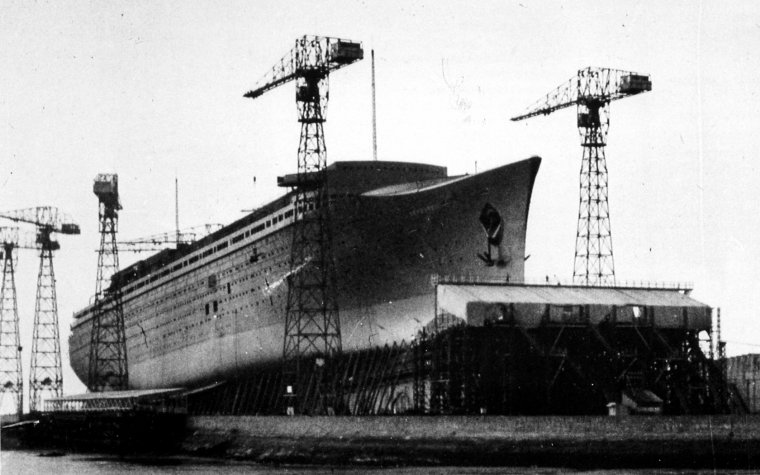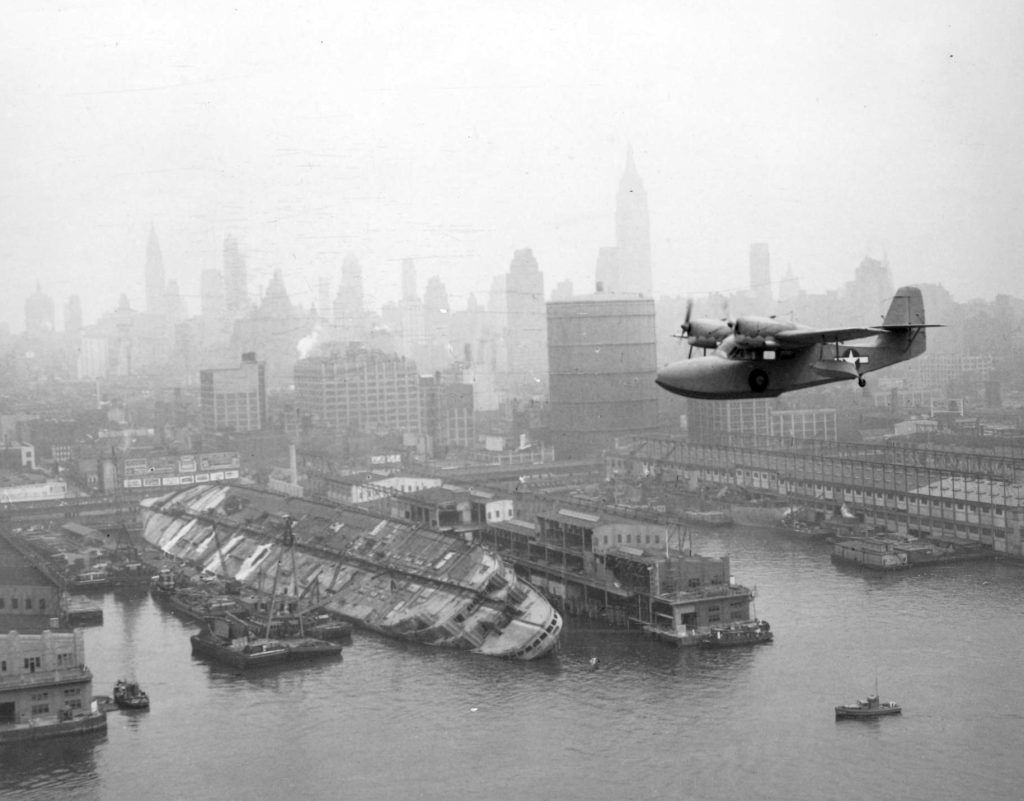The SS Normandie was a French ocean liner launched in 1932, celebrated for its luxurious design and advanced engineering. At the time of her maiden voyage in 1935, she was the largest and fastest ship in the world and held the Blue Riband for the fastest transatlantic crossing.

Unfortunately, during World War II, while being converted to a troopship in New York, the Normandie caught fire and capsized, marking an end to her short but illustrious career.
Origins Of The SS Normandie
The genesis of the SS Normandie was firmly rooted in an era characterized by fierce transatlantic competition among luxurious ocean liners.
In the late 1920s and early 1930s, multiple nations were engaged in a ferocious battle, not just for technological supremacy, but for the prestige that came with operating the fastest and most opulent vessels across the Atlantic.
The impetus behind the creation of the SS Normandie was propelled by this competitive spirit, and more so by the French’s desire to outshine their European neighbors, particularly Britain and Germany, in the realm of maritime accomplishment.
When the Compagnie Générale Transatlantique set about designing the SS Normandie, the underpinning goal was two-fold: to engineer a vessel that was not merely a means of conveyance, but a sculptural, moving entity of French art and culture, and to claim the illustrious Blue Riband.
 SS Normandie under construction in 1932. Image by Ocean Liners Magazine CC BY 2.
SS Normandie under construction in 1932. Image by Ocean Liners Magazine CC BY 2.
The ship’s design was overseen by naval architect Vladimir Yourkevitch, a former Russian naval officer who contributed significantly to its innovative hull design. The Normandie’s hull was a breakthrough in naval architecture, employing a hydrodynamic, bulbous bow that reduced drag, therefore enhancing speed, stability, and fuel efficiency.
Moreover, the Normandie was equipped with powerful turbo-electric propulsion, utilizing four turbo generators and two electric engines, which produced an astonishing 160,000 horsepower.
This formidable power not only enabled her to cruise at remarkable speeds but also allowed her to wrest the Blue Riband from her rivals shortly after her maiden voyage, crossing the Atlantic in just under four days.
In terms of aesthetic and interior design, the Normandie was a paean to the Art Deco movement, which was in its heyday during the ship’s conception and construction.
From the streamlined exterior that boasted curvilinear structures and sleek surfaces to the opulent interiors, the Normandie was a floating testament to the epoch.
The ship was imbued with luxurious features and spaces, including a grand dining hall that could accommodate hundreds and offered stunning sea views, an extravagant theater, and lavish staterooms, each meticulously decorated with a blend of traditional and modern French flair.
Interestingly, the SS Normandie was also the first ship where lifeboats were recessed into the superstructure, which not only provided a cleaner profile but also prevented the obstruction of promenade views for passengers enjoying a stroll on deck. This thoughtful integration of safety, utility, and aesthetic appeal was emblematic of the detail-oriented design approach employed throughout the creation of the vessel.
Inside The SS Normandie
One of the most awe-inspiring spaces aboard the Normandie was its first-class dining room. Covering an expansive three decks in height, it was not just a place to dine but an architectural marvel in itself.
The centerpiece of this dining haven was the splendid pillars of Lalique glass, shimmering in the ambient light, reflecting the luxury and opulence that the Normandie stood for.
These iconic pillars stood tall amidst long rows of tables adorned with the finest linens and silverware, where world-renowned chefs served exquisite French cuisine.
Imagine dining beneath a ceiling that seemed to touch the sky, enveloped by the soft glow of light, emanating from wall sconces and chandeliers, all while floating in the middle of the Atlantic.
 The extravagant main dining room inside the SS Normandie.
The extravagant main dining room inside the SS Normandie.
Staterooms and suites onboard the Normandie were nothing short of palatial. They were designed not just for comfort but for an elite experience. Rich woods, like mahogany and rosewood, paneled the walls.
Silken drapes cascaded gracefully alongside windows that offered sweeping views of the ocean, while plush carpets softened every step.
These rooms were furnished with bespoke furniture, from ornately carved headboards to lavish sofas, each piece bearing the hallmark of French craftsmanship.
Beyond the private spaces, the SS Normandie’s public areas were a confluence of luxury and leisure. Lounge areas were sumptuously furnished, providing passengers with spaces to relax, converse, or simply revel in the ship’s grandeur.
Art Deco motifs dominated the décor, with gleaming metals, geometric patterns, and sculptural elements combining to create an ambiance that was at once modern and timeless.
The onboard entertainment and recreational facilities were also unparalleled. The grand theater, which played host to some of the finest performances of the era, was an ode to art and culture.
With tiered seating, ornate detailing, and state-of-the-art acoustics, it offered passengers a cultural experience that rivaled the best theaters on land.
Adjacently, the indoor pool was not just a place for a swim but an architectural delight, adorned with mosaics, surrounded by lounging areas, and equipped with advanced facilities for the time.
Her Unfortunate Demise
The SS Normandie, despite its remarkable achievements and illustrious career, met a tragically untimely demise that marked the end of an era for this iconic ocean liner.
The backdrop against which the Normandie’s demise unfolded was the tumultuous period of World War II. When war broke out in Europe in 1939, the transatlantic travel industry faced significant challenges.
Travelers were understandably hesitant to cross the Atlantic, given the dangers posed by German U-boats, and the demand for luxury cruises plummeted. This starkly contrasted with the Normandie’s early years, when it had enjoyed widespread acclaim as the epitome of luxury and speed.
In 1940, France fell to German forces, and the Normandie found itself stranded in New York City, her port of call. It was a dire situation. The ship was essentially held hostage by the war, unable to return to its home country.
During this time, the United States was still officially neutral in the conflict, and the fate of the Normandie hung in the balance.
In 1942, with the United States’ entry into World War II following the attack on Pearl Harbor, the Normandie’s situation took a turn for the worse.
The U.S. government seized the vessel, viewing it as a valuable asset that could be converted into a troopship to support the war effort. The ship was renamed the USS Lafayette in honor of the Marquis de Lafayette, the French general who played a crucial role in the American Revolutionary War.
 The fire raging on the newly dubbed USS Lafayette.
The fire raging on the newly dubbed USS Lafayette.
The conversion process from a luxurious ocean liner to a troopship was a complex and challenging undertaking. In February 1942, tragedy struck when a fire broke out on board the Lafayette.
The fire began in the early morning hours and quickly spread, fueled by the ship’s wooden interiors and furnishings. Despite the valiant efforts of firefighters, the blaze proved difficult to control.
What made the situation even more dire was the massive amount of water used to combat the fire. The flooding that resulted from the firefighting efforts caused the Lafayette to capsize at its dock in New York Harbor. The sight of the once-proud ship lying on its side was a stark symbol of the ship’s tragic fate.
 A Grumman J4F Widgeon flies over the wreckage of the Lafayette.
A Grumman J4F Widgeon flies over the wreckage of the Lafayette.
Although the Lafayette was eventually righted, the damage sustained during the fire and subsequent capsize was deemed too extensive to justify the cost of repairs.
The U.S. Navy ultimately decided to scrap the ship in 1946, marking the end of the SS Normandie’s brief and unfortunate post-war chapter.
When Did The SS Normandie Sink?
The SS Normandie sank on 9th February 1942 when the liner caught fire during the conversion to a troopship. It caused Normandie to be overturned onto port and salvaged at a huge cost.
However, restoration was very costly and scrapped in 1946. This was a historical incident during the German attack on France.